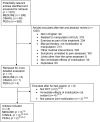The relative effectiveness of segment specific level and non-specific level spinal joint mobilization on pain and range of motion: results of a systematic review and meta-analysis
- PMID: 24421608
- PMCID: PMC3578190
- DOI: 10.1179/2042618612Y.0000000016
The relative effectiveness of segment specific level and non-specific level spinal joint mobilization on pain and range of motion: results of a systematic review and meta-analysis
Abstract
Study design: Systematic literature review and meta-analysis.
Objective: IN SYMPTOMATIC SUBJECTS TO: (1) examine the effects of a single session of joint mobilization on pain at rest and with most painful movement, and (2) compare the effects when joint mobilization is provided to a specific or non-specific spinal level.
Background: Joint mobilization is routinely used for treating spinal pain in conjunction with other interventions, but its unique effect is not well understood. Further, there is controversy about the role of 'specific level' techniques in producing benefit.
Methods: Searches were performed for randomized controlled trials (RCTs) using electronic databases (MEDLINE, CINAHL, and PEDro) from 1966 through November 2010. Methodological quality was assessed using previously detailed criteria. Meta-analysis and meta-regression were conducted on eligible studies.
Results: Eight RCTs with a mean methodological score of 10/12 were included. Significant heterogeneity (P = 0.075) was found in the overall meta-analysis estimate. When stratified by body location, no significant individual effect was found for pain at rest. However, there was a statistical mean difference [0.71 (95% confidence interval: 0.13-1.28)] between pain at rest for the cervical and lumbar individual means.
Conclusions: We found multiple studies which provided evidence that a single session of joint mobilization can lead to a reduction of pain at rest and with most painful movement. When using joint mobilization, the need for specific versus non-specific level mobilization may be influenced by anatomical region; the direction of effect in the cervical spine was toward specific mobilization and in the lumbar spine towards non-specific mobilization.
Keywords: Pain; Specific level; Spinal mobilization.
Figures





Similar articles
-
Effectiveness of Mulligan's Mobilization With Movement Techniques on Range of Motion in Peripheral Joint Pathologies: A Systematic Review With Meta-analysis Between 2008 and 2018.J Manipulative Physiol Ther. 2019 Jul;42(6):439-449. doi: 10.1016/j.jmpt.2019.04.001. Epub 2019 Jul 16. J Manipulative Physiol Ther. 2019. PMID: 31324377
-
Thoracic spine manipulation for the management of mechanical neck pain: A systematic review and meta-analysis.PLoS One. 2019 Feb 13;14(2):e0211877. doi: 10.1371/journal.pone.0211877. eCollection 2019. PLoS One. 2019. PMID: 30759118 Free PMC article.
-
The future of Cochrane Neonatal.Early Hum Dev. 2020 Nov;150:105191. doi: 10.1016/j.earlhumdev.2020.105191. Epub 2020 Sep 12. Early Hum Dev. 2020. PMID: 33036834
-
Complementary and alternative therapies for back pain II.Evid Rep Technol Assess (Full Rep). 2010 Oct;(194):1-764. Evid Rep Technol Assess (Full Rep). 2010. PMID: 23126534 Free PMC article. Review.
-
Is immediate imaging important in managing low back pain?J Athl Train. 2011 Jan-Feb;46(1):99-102. doi: 10.4085/1062-6050-46.1.99. J Athl Train. 2011. PMID: 21214357 Free PMC article.
Cited by
-
An international consensus on gaps in mechanisms of forced-based manipulation research: findings from a nominal group technique.J Man Manip Ther. 2024 Feb;32(1):111-117. doi: 10.1080/10669817.2023.2262336. Epub 2024 Jan 16. J Man Manip Ther. 2024. PMID: 37840477 Free PMC article.
-
Spinal mobilization vs conventional physiotherapy in the management of chronic low back pain due to spinal disk degeneration: a randomized controlled trial.J Man Manip Ther. 2017 May;25(2):66-73. doi: 10.1080/10669817.2016.1184435. Epub 2016 Jun 23. J Man Manip Ther. 2017. PMID: 28559665 Free PMC article.
-
Priorities in updating training paradigms in orthopedic manual therapy: an international Delphi study.J Educ Eval Health Prof. 2023;20:4. doi: 10.3352/jeehp.2023.20.4. Epub 2023 Jan 27. J Educ Eval Health Prof. 2023. PMID: 36702788 Free PMC article.
-
The effects of spinal manipulative therapy on lower limb neurodynamic test outcomes in adults: a systematic review.J Man Manip Ther. 2020 Feb;28(1):4-14. doi: 10.1080/10669817.2019.1569300. Epub 2019 Feb 5. J Man Manip Ther. 2020. PMID: 30935328 Free PMC article.
-
Immediate changes after manual therapy in resting-state functional connectivity as measured by functional magnetic resonance imaging in participants with induced low back pain.J Manipulative Physiol Ther. 2014 Nov-Dec;37(9):614-27. doi: 10.1016/j.jmpt.2014.09.001. Epub 2014 Oct 3. J Manipulative Physiol Ther. 2014. PMID: 25284739 Free PMC article. Clinical Trial.
References
-
- Allison G, Edmonston S, Kiviniemi K, Lanigan H, Simonsen AV, Walcher S. Influence of standardized mobilization on the posteroanterior stiffness of the lumbar spine in asymptomatic subjects. Physiother Res Int. 2001;6:145–56 - PubMed
-
- Powers CM, Kulig K, Harrison J, Bergman G. Segmental mobility of the lumbar spine during a posterior to anterior mobilization: assessment using dynamic MRI. Clin Biomech. 2003;18:80–3 - PubMed
Publication types
LinkOut - more resources
Full Text Sources
Other Literature Sources
Medical
